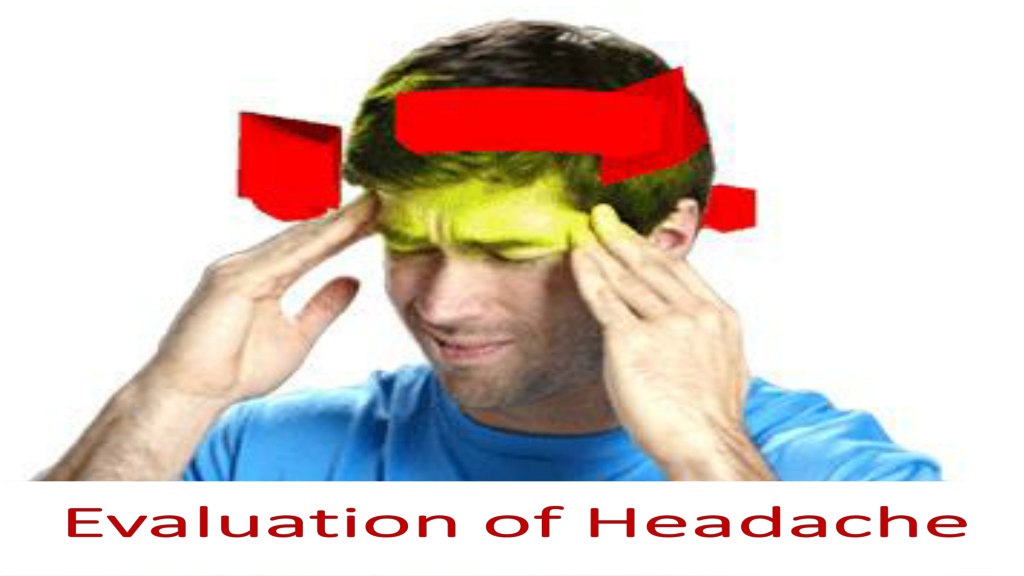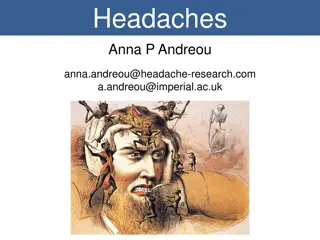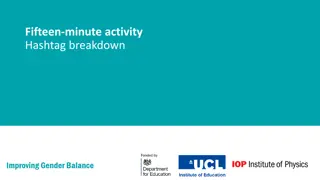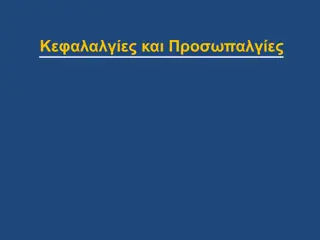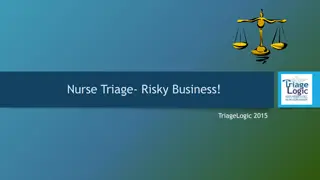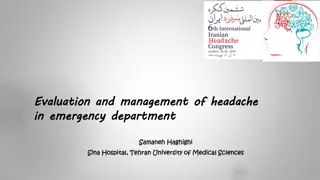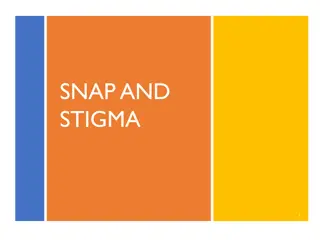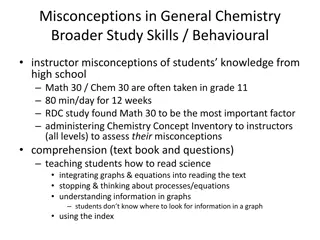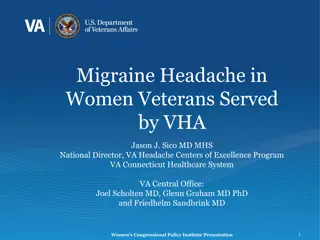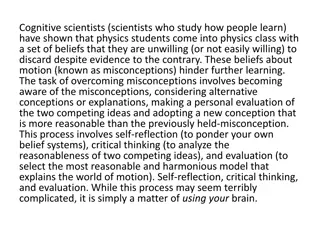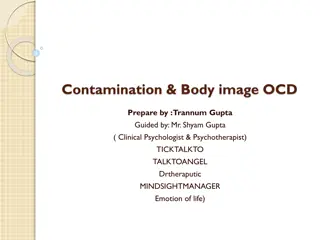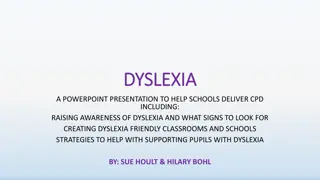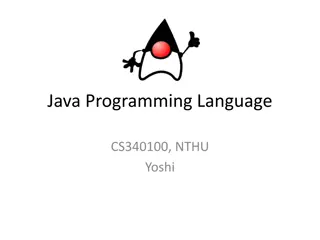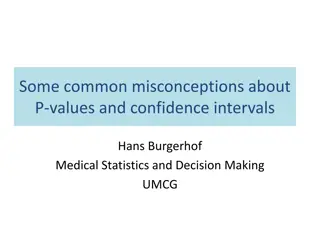Understanding Headaches: Types, Misconceptions, and Management Guidelines
Headaches are a common medical complaint affecting a significant portion of the population. This presentation delves into the various types of headaches, addresses common misconceptions such as sinus headaches and eye strain, and provides guidelines for the primary care management of headaches in adults. Learning objectives encompass diagnosing headaches, migraine prophylaxis, and treating tension and cluster headaches. A case scenario involving a 14-year-old boy with persistent headaches is also discussed.
Download Presentation

Please find below an Image/Link to download the presentation.
The content on the website is provided AS IS for your information and personal use only. It may not be sold, licensed, or shared on other websites without obtaining consent from the author. Download presentation by click this link. If you encounter any issues during the download, it is possible that the publisher has removed the file from their server.
E N D
Presentation Transcript
Outline Headache and its types Misconceptions Diagnostic approach Differential diagnosis Urgent considerations 2
Background: Background: Headache -is pain localized to any part of the head, behind the eyes or ears, or in the upper neck. -is among the most common medical complaints. -is one of the most common neurological problems presented to GPs and neurologists. Almost half (50%) of the adult population have had a headache at least once within the last year. (http://www.who.int/mediacentre/factsheets/fs277/en/) 3
Guideline for primary care management of headache in adults. Canadian Family Physician Headache on 15 or more days every month affects 1.7 4% of the world s adult population The estimated lifetime prevalence of headache is 66%: 46% to 78% for tension-type headache 14% to 16% for migraine 0.1% to 0.3% for cluster headache. Most common primary headache disorders are tension-type headache, migraine and cluster headache. 4
Learning objectives Learning objectives The best approach to diagnose patients with headache. Best practice for migraine prophylaxis. Treating tension / cluster headaches. Patient education 5
Misconceptions Misconceptions Acute or chronic sinusitis appears to be an uncommon cause of recurrent headaches, and many patients presenting with sinus headache turn out to have migraine. Patients frequently attribute headaches to eye strain. Headaches are only rarely due to refractive error alone. Hypertension can cause headaches: This is true in the case of hypertensive emergencies, it is probably not true for typical migraine or tension headaches. uptodate 6
Types of headaches Types of headaches PRIMARY SECONDARY Migraine Tension type Cluster Other trigeminal autonomic cephalalgias Space-occupying mass Vascular lesion Infection Metabolic disturbance Systemic problem. 7
Ahmed is a 14-year-old boy. He attends your clinic accompanied by his mother. He presents with a two months history of headaches that he describes as banging and that make his head very sore . He says that in the past two months, he has had 6 of these headaches. He also says that light hurts his eyes when he has the headaches. He does not feel nauseous or vomit during the headaches. 9
Mother tells you that when Ahmed has the headaches he is unable to go to school and that the headaches last from 2 to 4 hours. She gives Ahmed paracetamol and if that doesn t work she also gives him ibuprofen. This combination of medication helps. 10
12 Oxford handbook of general practice
You diagnose migraine without aura. How would you manage this? Reassure them that a serious underlying cause is unlikely Tell them that migraines are a well-recognised problem although what causes them is not known for certain Explain the risk of medication overuse headache 13
For acute management of migraine Taking into account the person's preference, comorbidities and risk of adverse events: Offer therapy: First line: Simple analgesics ( Ibuprofen 400 mg, ASA 1000 mg, naproxen sodium 500-550 mg, acetaminophen 1000 mg ) Second line: Triptans 14
uptodate Mild to moderate attacks not associated with vomiting - simple analgesics (NSAIDs, acetaminophen) or combination analgesics Moderate to severe attacks not associated with vomiting -oral migraine-specific agents are first-line, including oral triptans and the combination of sumatriptan-naproxen. When complicated by vomiting , non oral migraine-specific medications including subcutaneous sumatriptan OR nasal sumatriptan, non oral antiemetic agents 15
Managing patients with migraine Managing patients with migraine Pay attention to lifestyle and specific migraine triggers. Lifestyle factors to avoid include : -irregular or skipped meals -irregular or too little sleep -a stressful lifestyle -excessive caffeine consumption -lack of exercise obesity Use acute pharmacologic therapy for individual attacks Use prophylactic pharmacologic therapy, when indicated. Evaluate and treat coexistent medical and psychiatric disorders Guideline for primary care management of headache in adults. Canadian Family Physician 16
Managing patients with migraine Managing patients with migraine cont . Encourage patients to participate actively in their treatment: -self-monitoring to identify factors influencing migraine -maintaining a lifestyle that does not worsen migraine -practicing relaxation techniques -maintaining good sleep hygiene -using cognitive restructuring to avoid negative thinking -improving communication skills to talk effectively about pain with family and others -using acute and prophylactic medication appropriately 17
Aliya is a 28-year-old woman who was diagnosed with migraine with aura 6 months ago. She has, on average, 1 migraine attack per week, for which she takes an NSAID and an anti-emetic. Because Aliya has migraine about 4 times per month, she is unlikely to develop medication overuse headache. You are therefore happy with her current treatment plan. However, during an attack, she is unable to work or continue her normal daily activities. She also worries a lot about when the next attack is going to happen and their frequency causes her to take a lot of time off work. 19
You want to confirm that she is not a taking combined hormonal contraceptive for contraception purposes. Why? The World Health Organization, 2009 (medical eligibility criteria) recommends that the oral contraceptive pill should not be used in women with migraine with aura at any age. There is an increased risk of ischaemic stroke in people with migraine with aura. This risk is increased in women using combined hormonal contraception. Department of Reproductive Health WHO. Medical eligibility criteria for contraceptive use. 4th edition. World Health Organization; 2009 UK Medical Eligibility Criteria for contraception use. 2009 20
You suggest propranolol for migraine prophylaxis. a) How would you assess the effectiveness of the propranolol? Headache diary b) When would you review the need to continue this prophylaxis? -It might take 4-8 wk for substantial benefit to occur -If the prophylactic drug provides substantial benefit in the first 2 mo of therapy, this benefit might increase further over several additional months of therapy 6-12 months after the start of prophylactic treatment. Headaches in over 12s: diagnosis and management (2012 updated 2015) Guideline for primary care management of headache in adults Canadian Family Physician 21
She wants to become pregnant in the future, but still She wants to become pregnant in the future, but still needs migraine prophylaxis, what should you do? needs migraine prophylaxis, what should you do? Migraine without aura often improves during pregnancy. However, migraine with aura is more likely to continue throughout pregnancy. Seek specialist advice if prophylactic treatment for migraine is needed during pregnancy. Offer pregnant women paracetamol for the acute treatment of migraine. Headaches in over 12s: diagnosis and management (2012 updated 2015) 22
Abdullah is a 31-year-old man. He has a history of severe headaches, which are the worst pain he has ever felt. When he gets these headaches, he has pain on 1 side of his head, around his eye and along the side of his face. He also experiences watery eye and nasal congestion, on the same side as the headache. He experienced the headache for the first time 2 weeks ago. The CT scan done was normal and you have been asked to evaluate him. He tells you that, since his first severe headache 2 weeks ago, he has experienced 6 more headaches. He says that on average his severe headaches last from 30 to 90 minutes. 24
What advice and support can you offer about his diagnosis? Management primarily pharmacologic Offer O2 or a subcutaneous or nasal triptan for the acute treatment. What prophylaxis for cluster headache could you offer him? Prophylactic medication: consider offering him verapamil. Seek specialist advice before starting verapamil Early specialist referral recommended Guideline for primary care management of headache in adults, Canadian Family Physician 25
What medications would you not offer for the acute management of his cluster headache attacks? You would not offer paracetamol, NSAIDS, oral triptans, ergots or opioids as there is no evidence to suggest that they would have any clinical benefit in the treatment of cluster headache. NICE: https://www.nice.org.uk/donotdo/do-not-offer-paracetamol-nsaids-opioids-ergots-or-oral-triptans-for-the-acutetreatment-of-cluster-headache 26
General practice points for managing primary General practice points for managing primary headache in adults headache in adults Rule out secondary headache Imaging is not recommended for the routine assessment of patients with headache with normal neurologic examination findings, and no red flags. History and physical examination findings are usually sufficient to make a diagnosis Migraine should be considered in patients with recurrent moderate or severe headaches and normal neurologic examination findings Guideline for primary care management of headache in adults, Canadian Family Physician 27
General practice points General practice points cont . Consider a diagnosis of migraine in patients with a previous diagnosis of recurring sinus headache. Medication overuse is considered when patients with migraine or tension-type headache use combination analgesics, Opioids, or triptans on 10 d/mo or Acetaminophen or NSAIDs on 15 d/mo Comprehensive migraine therapy includes management of lifestyle factors and triggers, acute and prophylactic medications, and migraine self-management strategies 28
SNOOP( red flag signs) Systemic symptoms Neurologic symptoms fever, weight loss, cancer, pregnancy, immunocompromised state confusion, impaired alertness, papilledema, neurologic signs, meningismus, or seizures Onset Other associated conditions Age >40 years or sudden, "thunderclap head trauma, headache awakens from sleep, worse with Valsalva maneuvers, precipitated by cough, exertion Previous headache history headache progression or change in attack frequency, severity 29
Characteristics of migraine, tension Characteristics of migraine, tension- -type, and cluster headache syndromes syndromes Symptom Migraine type, and cluster headache Tension-type Cluster Adults: Unilateral in 60 to 70 percent, Children and adolescents: Bilateral in majority Always unilateral, usually begins around the eye or temple Location Bilateral Pain begins quickly, reaches a crescendo within minutes; pain is deep, continuous, excruciating, and explosive in quality Gradual in onset, crescendo pattern; pulsating; moderate or severe intensity; aggravated by routine physical activity Pressure or tightness which waxes and wanes Characteristics Patient appearance Patient prefers to rest in a dark, quiet room Patient may remain active or may need to rest Patient remains active Duration 4 to 72 hours 30 minutes to 7 days 15 minutes to 3 hours Ipsilateral lacrimation, redness of the eye; stuffy nose; rhinorrhea; pallor; sweating; Horner syndrome; Associated symptoms Nausea, vomiting, photophobia, phonophobia; may have aura None 30
Headache with visual impairment Temporal arteritis Acute glaucoma Headache with numbness New headache with cognitive change Headache with neck and face pain Thunderclap headache 31
Important elements in history : headache for the first time or Important elements in history : headache for the first time or those with a change in headache pattern those with a change in headache pattern Explore the following important elements : Headache onset (thunderclap, head or neck trauma) previous attacks (progression of symptoms) duration of attacks (4 hours, continuous) days per month with headache Pain location Headache-associated symptoms Relationship to precipitating factors (stress, posture etc) Effect on work and family activities Response to acute and preventive medications Presence of coexistent conditions (depression, asthma, etc) 32
Approach to the physical examination Approach to the physical examination Screening neurologic examination Neck examination Blood pressure measurement If indicated, a focused neurologic examination If indicated by associated jaw complaints, an examination for temporo-mandibular disorders 33
Red flags and other potential indicators of Red flags and other potential indicators of secondary headache secondary headache 34
Red flags Emergent (address immediately) Thunderclap onset Fever and meningismus Papilledema with focal signs or reduced LOC Acute glaucoma Guideline for primary care management of headache in adults, Canadian Family Physician Urgent (address within hours to days) Temporal arteritis Papilledema (WITHOUT focal signs or reduced LOC) Relevant systemic illness Elderly patient: new headache with cognitive change yes Refer and investigate Possible indicators of secondary headache Unexplained focal signs Atypical headaches Unusual aura symptoms Onset after age 50 y Aggravation by neck movement Abnormal neck examination findings (cervicogenic headache) Jaw symptoms (consider temporomandibular joint disorder) 35
Medication overuse Assess Ergots, triptans, combination analgesics, or codeine 10 d/mo OR Acetaminophen or NSAIDs 15 d/mo Manage Educate patient Consider prophylactic medication Provide an effective acute medication for severe attacks Gradual withdrawal of opioids if used Abrupt (or gradual) withdrawal of acetaminophen, NSAIDs, or triptans36 Headache with 2 of Nausea Light sensitivity Interference with activities migraine NO Tension type headache Headache with no nausea but 2 of Bilateral headache Non pulsating pain Mild to moderate pain Not worsened by activity
Acute Migraine Acute Migraine Medication Medication First line Ibuprofen 400 mg ASA 1000 mg naproxen sodium 500-550 mg acetaminophen 1000 mg Subcutaneous sumatriptan 6 mg if the patient is vomiting early in the attack. Nasal spray: sumatriptan 20 mg if patient is nauseated Antiemetics: domperidone 10 mg or metoclopramide 10 mg for nausea Second line Triptans: oral sumatriptan 100 mg Third line Naproxen sodium 500-550 mg in combination with a triptan Fourth line Fixed-dose combination analgesics (with codeine if necessary; not recommended for routine use 39
Prophylactic Medications Prophylactic Medications Prophylactic MEdications Starting dose Titration,* daily Dose increase Target dose or therapeutic range First line propranolol 20 mg twice daily 40 mg/wk 40-120 mg twice daily metoprolol 50 mg twice daily 50 mg/wk 50-100 mg twice daily amitriptyline 10 mg at bedtime 10 mg/wk 10-100 mg at bedtime Second line Topiramate 25 mg/d 25 mg/wk 50 mg twice daily 8 mg/d Few side effects; limited experience in prophylaxis Few drug interactions candesartan 8 mg/wk gabapentin 300 mg every 3-7 d 300mg/d 40
Medications for tension Medications for tension- -type headache type headache Medication Dose Acute Ibuprofen ASA Naproxen sodium Acetaminophen 400 mg 1000 mg 500-550 mg 1000 mg Prophylactic First line amitriptyline nortriptyline 10-100 mg/d 10-100 mg/d Second line mirtazapine venlafaxine 30 mg/d 150 mg/d 41
Aliya asks if there is anything that can be done to reduce the frequency of her migraine attacks. Explain that prophylactic treatments prevent, rather than cure, a condition. Depending on the person s clinical needs and their preferences offer prophylaxis with propranolol consider treatment with amitriptyline 43
Medication overuse headache (MOH) Also called analgesic rebound headache Consider a diagnosis in patients with headache on 15 d/mo possible medication overuse use of triptans, ergots, combination analgesics, or opioid-containing medications on 10 d/mo, or use of acetaminophen or NSAIDs on 15 d/mo MOH appears to be highest with opioids containing combination analgesics, and aspirin/acetaminophen/caffeine combinations. The risk with triptans is considered intermediate The risk is lowest with NSAIDs 44
Diagnosis of medication Diagnosis of medication- -overuse headache overuse headache When medication-overuse headache is suspected, the patient should also be evaluated for the presence of the following: -psychiatric comorbidities -psychological and physical drug dependence -use of inappropriate coping strategies. 45
Coping strategies for headache Rather than relying on medication as a main coping strategy, patients with suspected medication overuse might benefit from training in and development of more adaptive self-management strategies (eg, identification and management of controllable headache triggers, relaxation exercises, effective stress management skills, and activity pacing) Headache diaries that record acute medication intake are important in the prevention and treatment of medication-overuse headache 46
Headache on 15 d/ Headache on 15 d/mo normal neurologic examination findings normal neurologic examination findings mo for >3 for >3 mo mo and with and with Diagnose chronic migraine if headaches meet migraine diagnostic criteria or are quickly aborted by migraine-specific medications (triptans or ergots) on 8 d/mo. chronic" indicates a headache frequency of 15 or more days a month for longer than three months in the absence of organic pathology. Chronic migraine with medication overuse if the patient uses ergots, triptans, opioids, or combination analgesics on 10 d/mo or uses plain acetaminophen or NSAIDs on 15 d/mo -Chronic migraine without medication overuse if patients do not have medication overuse as defined above 47
Diagnose episodic tension-type headache if: headache attacks are not associated with nausea have at least 2 of the following: -bilateral headache -non pulsating pain -mild to moderate intensity -headache is not worsened by activity Diagnose chronic tension-type headache if : headaches meet episodic tension-type headache diagnostic criteria (above), except mild nausea might be present 48
Patients with continuous daily headache for >3 Patients with continuous daily headache for >3 mo with normal neurologic examination findings with normal neurologic examination findings Diagnose hemicrania continua if the headache -is strictly unilateral -is always on the same side of the head (ptosis or miosis might be present on examination) -responds dramatically to indomethacin. These attacks usually happen three to five times a day. Some people will have these headaches steadily for months or years. For others, the pain will go away for weeks or months, then come back. Like migraines, they can cause: Vomiting/nausea Sensitivity to noise or light Throbbing pain mo 49
Diagnose new daily persistent headache Diagnose new daily persistent headache If the headache is unremitting since its onset. It is important to consider secondary headaches in these patients. Neurologist referral recommended 50
